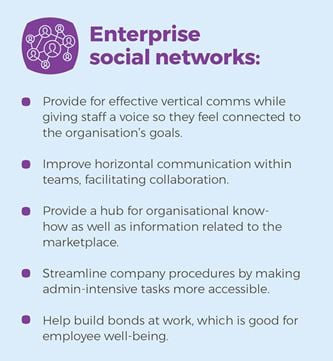Any company worth its salt wants that too. Research shows that businesses with good internal communication consistently outperform their competitors. As former Campbell’s Soup CEO Doug Conant put it: “To win in the marketplace you must first win in the workplace.”
“Good” goes way beyond the contents or “correctness” of a message though. Good communication means opening up avenues for dialogue, especially between leadership and employees. It means being able to measure the engagement on specific messages to get a sense of what’s resonating and what’s not – and adapt.
Where noticeboards and mailers can seem top-down, ESNs provide informality that empowers employees. And they let you look beyond open and click rates so you can get to know your people and hear what they have to say.
At the top of the ESN pile is Workplace by Facebook, which launched in beta as Facebook at Work with customers including the Royal Bank of Scotland. Facebook itself had been using a version of Workplace internally since 2011, before releasing it as a standalone product in 2016. The tools inherent to Facebook reduced the company’s reliance on internal emails and other software. Today Workplace has major clients in the FMCG (Nestlé, AB InBev), automotive (VW Ireland) and tech (Spotify) sectors. NGOs such as WWF and Oxfam use it as well.

Groups and instant messaging: these have obvious real-world applications. But it’s pretty obvious how they can help at work too. When you log into Workplace, you get a familiar Facebook-like News Feed. From there you can create or join groups for teams to collaborate on projects. Workplace groups work in the same way as Facebook groups. You can use them to write posts, add photos or videos, create events, upload files and create polls. The leap from sharing a commentable meme to sharing ideas or a commentable graph or report is not a huge one.
Workplace also maintains Facebook’s events functionality. That means you can organise meetings and other get-togethers from inside the platform. Then there’s Workplace Chat, an enterprise version of Facebook Messenger. Bye-bye, Outlook and maybe even Slack.
Workplace has additional features that significantly increase the scope of what you can do with it out of the box. It allows organisations to integrate with other Software as a Service (SaaS) tools (for HR, cloud storage etc) as well as build bespoke solutions. For example, one of our clients has created a Workplace chatbot to make it easier for their employees to go through the procurement process. This has the potential to reduce admin within the business and turn something tedious into something impressive.
The benefit of all this to internal communications specialists is you have an entire company – even a multinational – in one place. A product like Workplace is the ideal place to engage employees, since that’s where they already are. Workplace is, of course, like Facebook, mobile friendly too. This gives us an amazing opportunity to tap into commute time. When your employees are on their smartphones in the train they could be liking and commenting on your infographics and videos.
Workplace is far from the first ESN though. Yammer has provided employers with a place to make announcements, share stories and answer questions since 2008. (You may recall that Facebook circa 2008 was a pre-Timeline mess of “is” status updates and poorly designed app integrations. How far we’ve come.) Another big player in the ESN space is SocialChorus. With an emphasis on crafted content, this platform provides one place to plan, create, publish, and measure internal comms. SocialChorus has notched up an impressive array of clients too, including Ford and Vodafone.
The one thing all ESNs have in common is that they connect people – just like Facebook, Twitter and Instagram – but in a closed, secure environment. This helps facilitate the most on-trend way of working right now: flexibility. And it brings the sense of belonging that comes with being part of a team.
This is a world where planned internal comms complements spontaneous social networking behaviour. Company announcements, industry news and resources feature alongside lifestyle-type content that inspires. Employees feel included in the company’s vision and purpose. They understand the competitive landscape. And they feel valued.
But what does that mean for a business?
Let’s talk money. A 2012 McKinsey & Company study concluded that social-savvy companies could double their productivity. An increase in productivity lets a company do more without increasing its costs. In other words, a valued employee will bring you value. That’s great news for everyone, not least the suits who focus on the bottom line.
Key to creating this value is how well a company communicates its vision and purpose. People want to work with you because your vision and purpose align with their own. They’re looking for meaning and you could help bring that. But it’s no good just to tell your people what you’re about; you have to demonstrate it by embedding best internal comms practice into your business.
Technology has shaped the 21st century. We’re always connected – in our personal and professional lives, at home and at work. Companies that embrace the kinds of communication tools their staff are already using have an advantage. ESNs like Workplace and SocialChorus make internal comms as natural as chatting with an old friend or family member. It’s no surprise that some of the biggest multinationals are tapping into this to connect with their employees.
For more insight into the State of Internal Communications in South Africa, download New Media’s first-of-its-kind report investigating how South African employees experience communication in the workplace.
